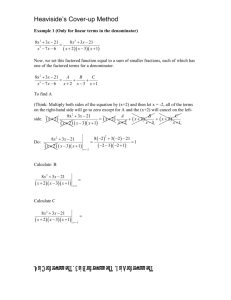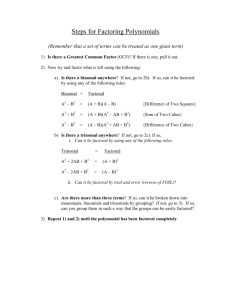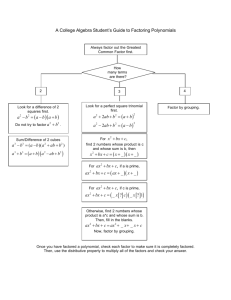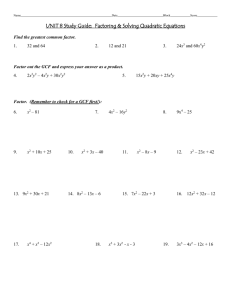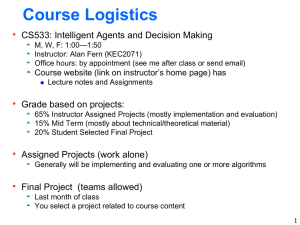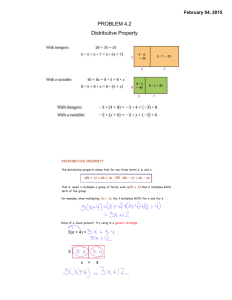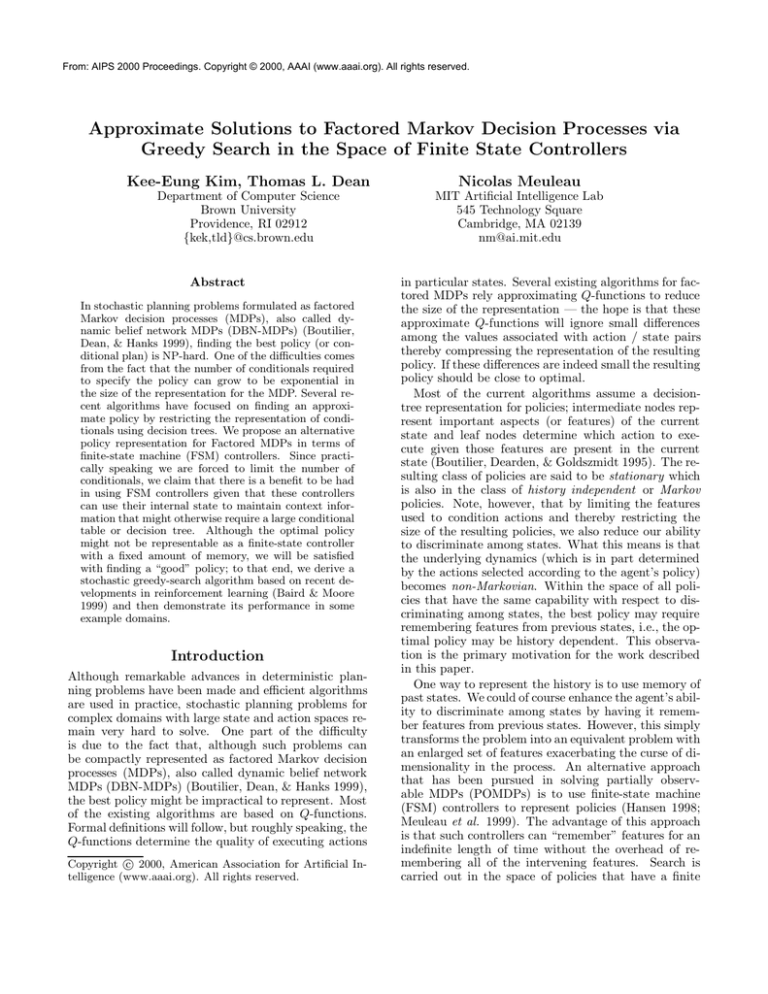
From: AIPS 2000 Proceedings. Copyright © 2000, AAAI (www.aaai.org). All rights reserved.
Approximate Solutions to Factored Markov Decision Processes via
Greedy Search in the Space of Finite State Controllers
Kee-Eung Kim, Thomas L. Dean
Nicolas Meuleau
Department of Computer Science
Brown University
Providence, RI 02912
{kek,tld}@cs.brown.edu
MIT Artificial Intelligence Lab
545 Technology Square
Cambridge, MA 02139
nm@ai.mit.edu
Abstract
In stochastic planning problems formulated as factored
Markov decision processes (MDPs), also called dynamic belief network MDPs (DBN-MDPs) (Boutilier,
Dean, & Hanks 1999), finding the best policy (or conditional plan) is NP-hard. One of the difficulties comes
from the fact that the number of conditionals required
to specify the policy can grow to be exponential in
the size of the representation for the MDP. Several recent algorithms have focused on finding an approximate policy by restricting the representation of conditionals using decision trees. We propose an alternative
policy representation for Factored MDPs in terms of
finite-state machine (FSM) controllers. Since practically speaking we are forced to limit the number of
conditionals, we claim that there is a benefit to be had
in using FSM controllers given that these controllers
can use their internal state to maintain context information that might otherwise require a large conditional
table or decision tree. Although the optimal policy
might not be representable as a finite-state controller
with a fixed amount of memory, we will be satisfied
with finding a “good” policy; to that end, we derive a
stochastic greedy-search algorithm based on recent developments in reinforcement learning (Baird & Moore
1999) and then demonstrate its performance in some
example domains.
Introduction
Although remarkable advances in deterministic planning problems have been made and efficient algorithms
are used in practice, stochastic planning problems for
complex domains with large state and action spaces remain very hard to solve. One part of the difficulty
is due to the fact that, although such problems can
be compactly represented as factored Markov decision
processes (MDPs), also called dynamic belief network
MDPs (DBN-MDPs) (Boutilier, Dean, & Hanks 1999),
the best policy might be impractical to represent. Most
of the existing algorithms are based on Q-functions.
Formal definitions will follow, but roughly speaking, the
Q-functions determine the quality of executing actions
c 2000, American Association for Artificial InCopyright telligence (www.aaai.org). All rights reserved.
in particular states. Several existing algorithms for factored MDPs rely approximating Q-functions to reduce
the size of the representation — the hope is that these
approximate Q-functions will ignore small differences
among the values associated with action / state pairs
thereby compressing the representation of the resulting
policy. If these differences are indeed small the resulting
policy should be close to optimal.
Most of the current algorithms assume a decisiontree representation for policies; intermediate nodes represent important aspects (or features) of the current
state and leaf nodes determine which action to execute given those features are present in the current
state (Boutilier, Dearden, & Goldszmidt 1995). The resulting class of policies are said to be stationary which
is also in the class of history independent or Markov
policies. Note, however, that by limiting the features
used to condition actions and thereby restricting the
size of the resulting policies, we also reduce our ability
to discriminate among states. What this means is that
the underlying dynamics (which is in part determined
by the actions selected according to the agent’s policy)
becomes non-Markovian. Within the space of all policies that have the same capability with respect to discriminating among states, the best policy may require
remembering features from previous states, i.e., the optimal policy may be history dependent. This observation is the primary motivation for the work described
in this paper.
One way to represent the history is to use memory of
past states. We could of course enhance the agent’s ability to discriminate among states by having it remember features from previous states. However, this simply
transforms the problem into an equivalent problem with
an enlarged set of features exacerbating the curse of dimensionality in the process. An alternative approach
that has been pursued in solving partially observable MDPs (POMDPs) is to use finite-state machine
(FSM) controllers to represent policies (Hansen 1998;
Meuleau et al. 1999). The advantage of this approach
is that such controllers can “remember” features for an
indefinite length of time without the overhead of remembering all of the intervening features. Search is
carried out in the space of policies that have a finite
From: AIPS 2000 Proceedings. Copyright © 2000, AAAI (www.aaai.org). All rights reserved.
R
R
amount of memory.
It is important to note than in a (fully observable)
MDP, the state contains all of the information required
to choose the optimal action. Unfortunately, the current state may not encode this information in the most
useful form and decoding the information may require
considerable effort. In some domains, however, there is
information available in previous states that is far more
useful (in the sense of requiring less computational effort to decode for purposes of action selection) than
that available in the present state. For example, in New
York city it is often difficult to determine that gridlock
has occurred, is likely to occur, or is likely to persist
even if you have all of the information available to the
Department of Transportation Traffic Control Center;
however, if on entering the city around 3:00pm you note
that traffic at the George Washington Bridge is backed
up two miles at the toll booths, and you find yourself
still in the city around 5:00pm, your best bet is to relax,
do some shopping, have dinner in the city, and generally avoid spending several frustrating hours fuming in
your car on the Triborough Bridge. We will return to
a more formal example in a later section.
There are recent algorithms for reinforcement learning that assume the use of finite-state controllers for
representing policies (Hansen 1998; Meuleau et al.
1999). These algorithms are intended to solve POMDPs
and non-Markov decision problems. We argue that,
as described in the previous paragraphs, the policy we
search for should be history dependent if the problem is
given as an MDP with a very large state space and the
space of the policies determined by the agent’s ability
to discriminate among states does not cover the optimal
memoryless policy.
In this paper, we adopt the approach of searching
directly in the space of policies (Singh, Jaakkola, &
Jordan 1994) as opposed to searching in the space of
value functions, finding the optimal value function or
a good approximation thereof and constructing a policy from this value function. Finding the best FSM
policy is a hard problem and we side step some of the
computational difficulties by using a stochastic greedy
search algorithm (also adapted from work in reinforcement learning (Baird & Moore 1999)) to find a locally
optimal finite state controller.
The inspiration for our approach came from the work
of Meuleau et al. (1999) that restricted attention to the
space of finite-state controllers and applied the VAPS
family of algorithms (Baird & Moore 1999) to searching in the space of such policies. Our contribution is to
show that the same basic ideas can be applied to solving factored MDPs with very large state spaces. There
is nothing in principle preventing us from combining
our work with that of Meuleau et al. to solve factored
POMDPs in which a domain model is supplied. In this
work, we see the availability of a factored domain model
as an important advantage to be exploited.
The paper is organized as follows: We begin by
formalizing stochastic planning problems as factored
U
U
W
W
HC
HC
WC
WC
t
t+1
Pr(R t+1 R t)
Rt
1.0
Pr(U t+1 U t)
Ut
Pr(W t+1 R t ,U t ,W t)
Wt
1.0
1.0
0.0
Pr(HC t+1 HC t)
WC t
0.9
1.0
Rt
Ut
Pr(WC t+1 WC t)
HC t
1.0
0.0
0.1
0.0
1.0
0.0
Figure 1: Compact representation of a robot action,
GetCoffee.
WC
1
1
4
0
HC
W
0
1
1
0
0
2
Figure 2: Compact representation of the reward function for the toy robot problem.
MDPs. We define the class of FSM policies that constitutes the space of possible solutions to the given problem. We then describe a local greedy search algorithm
and investigate its performance by summarizing experimental results on examples of stochastic planning problems.
Factored MDPs
In this paper, we consider factored MDPs as input problems that generalize on propositional STRIPS problems. The factored MDP can be represented as a
graphical model. An example is shown in Figure 1,
which describes a toy robot planning problem. The
ovals represent fluents in the domain. In this case,
R, U, W, HC, W C are binary variables representing, respectively, the weather outside being rainy, the robot
having an umbrella, the robot being wet, the robot
holding coffee, and the robot’s boss wanting coffee. The
connections between the fluents at time step t + 1 and
t determine the dynamics. The conditional probability
distribution governing state transitions is represented in
terms of a set of conditional probability distributions,
one for each fluent, shown as a tree in the right side of
the Figure 1. The product of these distributions determines the state-to-state transition probability function.
Since the dynamics of the state space depends on the
action, we specify a graph representing the dynamics for
each action. The figure shows the graph for one particular action, GetCoffee. To complete the specification,
the reward function is also provided in a decision tree
format. In Figure 2, we show an example of the reward
function associated with the toy robot problem.
From: AIPS 2000 Proceedings. Copyright © 2000, AAAI (www.aaai.org). All rights reserved.
Definition 1 (Factored MDP) A factored MDP
~ A, T, R} is defined as
M = {X,
~ = [X1 , . . . , Xn ] is the set of fluents that de• X
fines the state space. We use the lowercase letter
~x = [x1 , . . . , xn ] to denote a particular instantiation
of the fluents.
• A is the set of actions.
• T is the set conditional probability distributions, one
for each action:
n
Y
P (xi,t+1 |pa(xi,t+1 ), a)
T (~xt , a, ~xt+1) =
i=1
where pa(Xi,t+1 ) denotes the set of parent variables of Xi,t+1 in the graphical model. Note that
∀i, pa(Xi,t+1 ) ⊆ {X1,t , . . . , Xn,t }.
~ → < is the reward function. Without loss of
• R:X
generality, we define the reward to be determined by
~ × A → <).
both state and action (R : X
2
We define an explicit randomized history-independent
~ × A to [0, 1]. In words, π
policy π as a function from X
defines a probability distribution over actions given that
the system is in a specific state. Note that the size of the
table for storing the probability distribution is exponential in the number of fluents (hence the term explicit).
Every Factored MDP is associated with an objective
function. In this paper, we restrict our attention to
one particular objective function, infinite horizon expected cumulative discounted reward with discount rate
0 < γ < 1. To compare the quality of policies, we define
the following functions.
Definition 2 (Value Functions and Q-Functions)
The value function of the explicit history-independent
policy π is defined as
X
X
π(~x, a) R(~x, a) + γ
T (~x, a, x~0)V π (x~0 ) .
V π (~x) =
a
x~0
The Q-function of the policy π is defined as
X
T (~x, a, x~0)V π (x~0 ).
Qπ (~x, a) = R(~x, a) + γ
~0
x
2
In words, V π (~x) denotes the expectation of total discounted reward throughout the future starting from the
state ~x and following the policy π. Qπ (~x, a) denotes the
expectation of total discounted reward throughout the
future starting from the state ~x, executing action a, and
then following the policy π.
The optimal randomized explicit history-independent
policy π ∗ is defined as
π ∗ = arg max V π .
π
For the sake of simplicity, we denote the value function
for the optimal policy π ∗ as V ∗ and call it the optimal
value function.
We now ask ourselves whether there exists a historydependent policy π̃ such that V π̃ > V ∗ . In the case of
explicit policies, the answer is “no” due to the following
theorem.
Theorem 1 (Page 143, Puterman (1994))
max V π̃ = max V π
π̃∈ΠHR
π∈ΠMR
where ΠHR and ΠMR represent the set of explicit randomized history-dependent policies and the set of explicit randomized history-independent policies, respectively.
2
A popular way to deal with the explosion in the size
of the representation of π is to aggregate the atomic
states that have same V π (~x). Often, this is not enough,
so we go further and aggregate the states that have approximately same value until the size of the representation becomes tractable. Unfortunately, this breaks the
above theorem. It is easy to observe that by doing so,
the problem becomes a POMDP. This justifies our claim
that we should search in the space of history-dependent
policies instead of history-independent policies. In the
next section, we formally derive a special case in which a
history-dependent policy results in an exponential saving in size compared to a history-independent policy.
Finite Policy Graphs
(Conditional Plans)
A deterministic policy graph for a given Factored MDP
is a directed graph (V, E) where each vertex v ∈ V is labeled with an action a ∈ A, and each arc e ∈ E is labeled
with some boolean function fe (~x). Also for each vertex, there is one and only one outgoing arc that satisfies
the associated boolean function. When the controller
is at a certain vertex, it executes the action associated
with the vertex. This implies a state transition in the
underlying MDP. Upon observing the new state ~x, the
controller takes the appropriate outgoing arc and arrives at the destination vertex.
In this paper, we focus on stochastic policy graphs
in which the action choices and vertex transitions are
probabilistic. Further, we assume that all the labeled
boolean functions take only one of the n fluents as input.
Definition 3 (Unary Stochastic Policy Graphs)
A unary stochastic policy graph is defined by the
following parameters.
• V is the set of vertices in the graph.
• E is the set of directed edges in the graph.
• ψ(v, a) is the probability of choosing action a in vertex
v ∈ V:
ψ(v, a) = P (At = a|Vt = v)
for all time steps t.
• η((v, i), xi , (v0 , i0 )) is the joint probability of moving
from vertex v ∈ V and focusing on the fluent Xi to
From: AIPS 2000 Proceedings. Copyright © 2000, AAAI (www.aaai.org). All rights reserved.
X1
0
X1
0
……
……
……
Vt
V t+1
Figure 3: Influence diagram illustrating the policy
graph coupled with a Factored MDP.
vertex v0 ∈ V and focusing on the fluent Xi0 , after
observing xi ∈ Xi :
η((v, i), xi , (v0 , i0 ))
= P (Vt+1 = v0 , It+1 = i0 |Vt = v, It = i, Xi,t+1 = xi )
for all time steps t.
• ηI0 (i) is the probability distribution for focusing on
the fluent Xi at time step 0.
ηI0 (i) = P (I0 = i)
• ηV0 (i, xi , v) is the probability distribution for the initial vertex v0 conditioned on the event that the initial
focus is on the fluent Xi and its value is xi :
ηV0 (i, xi , v) = P (V0 = v|I0 = i, Xi,0 = xi )
Xn
Xn
Xn
1
Xn
1
Y
k
Y
k
Y
k
Y
1
Y
0
Z
0
Z
1
Z
2
Z
2n-1
Z
2n
A
A
A
A
A
1
R
R
R
R
R
t
(a)
t+1
t+2
t+2n-1
t+2n
……
Figure 4: A task determining majority represented as
a Factored MDP. (a) answer generation phase : In this
example, Y is sampled to be k at time t. (b) problem instance generation phase : Then, exactly k fluents
among X1 , . . . , Xn are set to 1 by the time t + 2n. In
this example, X1 is sampled to be 1 and Xn to be 0.
X1
0
X1
0
Xn
1
Y
0
Y
–n
Z
2n
X1
0
……
Xn
1
X1
0
……
……
Figure 3 shows the diagram of the policy graph. All
the dotted links represent the parameters of the policy.
There is a range of possible structures for the policy.
We can make the policy reactive in the sense that there
is no memory associated with the finite-state controller,
it is fixed constant all the time, and the distribution on
at is determined by xi,t only. HQL-type policies (Wiering & Schmidhuber 1997), that consist of a sequence of
reactive policies, can be modeled as well, by having |V|
as large as the number of reactive policies and associating goal state and fluent index with the vertex in the
policy graph.
Now we might ask what kind of leverage we can get by
using this kind of history-dependent policies? Consider
the problem given as a Factored MDP shown in Figure 4 and Figure 5. The Factored MDP is constructed
in such a way that its state is a randomly generated instance of the majority problem and the reward is given
when the correct answer is given as the action. Thus,
the optimal policy is to generate the answer corresponding to whether the majority of bits in a random n-bit
vector is set or not. The Factored MDP representation
is composed of n + 2 variables, where X1 , . . . , Xn represent the n-bit vector encoding the problem instance,
Y represents the answer to the problem (yes or no),
……
(b)
……
2
X1
0
Xn
I t+1
At
X1
0
……
It
X n,t+1
X1
……
X i,t
X 1,t+1
……
……
X n,t
…… ……
X 1,t
Xn
1
Xn
1
Y
– n +k-1
Y
– n +k
Z
2n+1
Z
3n-1
Z
3n
A
1
A
A
A
R
R
R
R
t+3n-1
(d )
t+3n
t+2n
(c)
t+2n+1
……
……
Figure 5: A task determining majority represented as
a Factored MDP (continued from Figure 4). (c) answer guess phase: In this example, at time t + 2n, the
guess “yes” is fed into the Factored MDP. (d) answer
verification phase: The guess answer is checked and the
reward of 1.0 will be given at time t + 3n if and only if
−n/2 < −n + k ≤ n/2.
From: AIPS 2000 Proceedings. Copyright © 2000, AAAI (www.aaai.org). All rights reserved.
and Z represents a counter for keeping track of the four
phases of the process:
0
answer generation phase,
z ∈ [1, 2n]
problem instance generation phase,
Z=
2n
answer guess phase,
z ∈ [2n+1,3n] answer verification phase.
The dynamics of the Factored MDP is described as
follows. Unless otherwise specified, all fluents except
Z retain values from the previous time step, and Z is
increased at each time step:
Answer generation phase : Randomly generate an
answer.
[Time t] X1,t , . . . , Xn,t retain values from the previous time step. Yt is set to a random number
yt ∈ [1, n]. Zt is set to 0.
Problem instance generation phase : Randomly
generate a problem instance corresponding to the answer generated in the previous phase.
[Time t + 1 ∼ t + 2n] For 1 ≤ i ≤ n, Xi,t+2i−1 is set
to one with probability min[yi,t+2i−2/(n − i + 1), 1]
at time t+2i−1. Yt+2i is set to yt+2i−1 −xi,t+2i−1.
In short, throughout the problem generation phase,
the MDP generates a random n-bit vector which
has yt bits set to 1, and Y serves as a counter
keeping track of how many more bits should be
set.
Answer guess phase : The answer is guessed by the
current policy.
[Time t + 2n] An action is taken, which corresponds to the guess whether the majority of the
X1 , . . . , Xn are set or not. 0 means the answer
“no” and 1 means “yes”.
Answer verification phase : The answer is verified
by counting the number of fluents that are set to 1
among fluents X1 , . . . , Xn .
[Time t + 2n + 1] Yt+2n+1 is set to at+2n ∗ (−n) +
x1,t+2n.
[Time t + 2n + 2 ∼ t + 3n] For 2 ≤ i ≤ n, Yt+2n+i
is set to yt+2n+i−1 + xi,t+2n+i−1.
[Time t + 3n] If −n/2 < Yt+3n ≤ n/2, the guess
was correct, so the reward of 1 is given. Otherwise,
no reward is given.
[Time t + 3n + 1] The system gets back to the answer generation phase (time t).
A history-independent policy represented as a tree
should be able to count the number of bits set among
X1 , . . . , Xn . It will, however, explode the size of the
tree. On the other hand, a history-dependent policy
with sufficient amount of memory (size of 2 in the above
case) can remember the answer. Hence, the latter will
not explode.
Local Greedy Policy Search
Searching in the space of history-dependent policies
does not make the problem any easier. In this paper,
we use a local greedy search method based on Baird
and Moore’s VAPS algorithm (Baird & Moore 1999)
and its predecessor REINFORCE algorithm (Williams
1988). It is a trial-based, stochastic gradient descent of
a general error measure, and hence we can show that it
converges to a local optimum with probability 1. The
error measure we use in this paper is the expected cumulative discounted reward:
∞
hX
i
γ t R(~xt , at )|~x0 , π
Bπ = E
t=0
Assume that the problem is a goal-achievement task —
there exists an absorbing goal-state which the system
must be in as fast as possible. As soon as the system
reaches the goal-state, the system halts and assigns a
reward. In this case, we can write down our optimality
criterion as
∞
X
X
P (hT |~x0 , π)(hT ),
(1)
Cπ =
T =0 hT ∈HT
where HT is the set of all trajectories that terminate at
time T , i.e.,
hT = [~x0 , v0 , i0 , a0 , r0, . . . , ~xT , vT , iT , aT , rT ]
and (hT ) denotes the total error associated with trajectory hT . We assume the total error is additive in
the sense that
(hT ) =
T
X
e(hT [0, t])
t=0
where e(hT [0, t]) is an instantaneous error associated
with sequence prefix
hT [0, t] = [~x0 , v0 , i0 , a0 , r0 , . . . , ~xt, vt , it , at , rt ]
Among the many ways of defining e, we use TD(1)
error (Sutton & Barto 1998) which is
e(hT [0, t]) = −γ t rt .
In this case, we note that our objective function (Equation 1) is exactly −Bπ , therefore we try to minimize
Cπ .
To illustrate the stochastic gradient descent algorithm on Cπ , we derive the gradient ∇Cπ with respect
to the parameters of the policy graph. From Definition 3, the parameter space is {ψ, η, ηI0 , ηV0 }. Without
loss of generality, let ω be any parameter of the policy
graph. Then we have
∞
X
X h
∂(hT )
∂Cπ
=
P (hT |~x0 , π)
∂ω
∂ω
T =0 hT ∈HT
(2)
∂P (hT |~x0 , π) i
.
+ (hT )
∂ω
From: AIPS 2000 Proceedings. Copyright © 2000, AAAI (www.aaai.org). All rights reserved.
Note that for our choice of the partial derivative of
(hT ) w.r.t. ω is always 0. We now derive the partial
derivative of P (hT |~x0 , π) w.r.t. ω. Since
1.8
1.6
P (hT |~x0, π) =P (~x0 )ηI0 (i0 )ηV0 (i0 , xi,0, v0 )ψ(v0 , a0 )
T h
Y
T (~xt−1 , at−1 , ~xt)
t=1
2
1.4
i
η((vt−1 , it−1 ), xi,t, (vt , it ))ψ(vt , at ) ,
1.2
1
0.8
we can rewrite Equation 2 as
∞
T
h
X
X
X
∂ ln ψ(vt , at )
∂Cπ
=
P (hT |~x0 , π) (hT )
∂ω
∂ω
t=0
T =0 hT ∈HT
+ (hT )
T
X
∂ ln η((vt−1 , it−1 ), xi,t , (vt , it ))
∂ω
t=1
∂ ln ηI0 (i0 )
+ (hT )
∂ω
∂ηV0 (i0 , xi,0 , v0 ) i
.
+ (hT )
∂ω
+ (hT )
∂ω
T
X
∂ ln η((vt−1 , it−1 ), xi,t, (vt , it ))
∂ω
t=1
∂ ln ηI0 (i0 )
∂ω
∂ηV0 (i0 , xi,0, v0 )
+
∂ω
+
(3)
w.r.t. the distribution P (hT |~x0 , π). Hence, stochastic gradient descent of the error is done by repeatedly
sampling a trajectory hT and evaluating g(hT ) and updating the parameters of the policy graph.
It is important that we have non-zero probabilities
for all possible trajectories. One way to enforce this
condition is to use a Boltzmann distribution for the parameters of the policy graph:
eQψ (v,a)
Qψ (v,a0)
a0 ∈A e
0 0
eQη ((v,i),xi,(v ,i ))
η((v, i), xi , (v0 , i0 )) = P
Qη ((v,i),xi ,(v 00 ,i00 ))
v 00 ∈V,i00 e
ψ(v, a) = P
QηI (i)
e
ηI0 (i) = P
i0
ηV0 (i, xi , v) = P
0
QηI (i0 )
e 0
Q
(i,x ,v)
e ηV0 i
v 0∈V
QηV (i,xi ,v 0)
e
shuttle
optimal
0.2
0
1000
2000
3000
4000
Preliminary Experiments
T
X
∂ ln ψ(vt , at )
t=0
0.4
Figure 6: Performance on the modified shuttle problem.
The above equation suggests that the gradient is the
mean of
g(hT ) = (hT )
0.6
0
Throughout the experiments described in the next section, we use the above reparameterization.
In this section, we show some results from our preliminary experiments.
Figure 6 presents the learning curve of the policy
graph on a modified version of a benchmark problem
for evaluating POMDP algorithms called the “shuttle
problem.” The original shuttle problem (Cassandra
1998) is given as a POMDP, where the task is driving a shuttle back and forth between a loading site and
an unloading site to deliver a package. The status of
whether the shuttle is loaded or not is hidden. For
our experiments, we modified the problem so that everything is observable — it is now composed of three
fluents, that represent the location of the shuttle, the
status of loaded or not, and the status of the package’s
arrival at the loading site, respectively. A reward of
1 is given every time the shuttle arrives at the loading site with empty cargo and returns to the unloading
site with the package. With the discount rate of 0.9,
the optimal performance is around at 1.9. The graph
shows the average of 10 independent experiments each
with 4000 gradient updates on a policy graph with 2
vertices.
Figure 7 shows the performance of the algorithm on
the toy coffee robot problem. It is an extended version of the simple problem in Figure 1. When explicitly
enumerated (i.e. flattened out), the problem has 400
states. By using a policy graph with 2 vertices, we
were able to find a locally optimal policy within minutes. The optimal performance is 37.49. The graph
shows the average of 10 independent experiments each
with 4000 gradient updates. On average, the learned
policy graphs had performance around at 25. We expected to learn a gradually better policy as we added
more vertices, but we ended up stuck at local optima
with same performance. The result is to be expected
given that the algorithm looks for local optima; however, the result is in contrast to what we observed in
From: AIPS 2000 Proceedings. Copyright © 2000, AAAI (www.aaai.org). All rights reserved.
40
Related Work
35
There is a large and growing literature on the efficient representation and solution of problems involving
planning under uncertainty modeled as Markov decision processes (see (Boutilier, Dean, & Hanks 1999)
for a survey) that draws upon earlier work in operations research (see (Bertsekas 1987; Puterman 1994)
for an overview). In particular, there has been much
work recently representing large MDPs using compact, factored representations such as Bayesian networks (Boutilier, Dearden, & Goldszmidt 1995; Dean,
Givan, & Leach 1997; Dean, Givan, & Kim 1998;
Hauskrecht et al. 1998).
Roughly speaking, the computational complexity of
solving MDPs is polynomial in the size of the state
and action spaces (Littman, Dean, & Kaelbling 1995)
and the typical factored MDP has state and action
spaces exponential in the size of the compact representation of the dynamics (the state-transition and reward functions). Methods from reinforcement learning (see (Kaelbling, Littman, & Moore 1996; Sutton &
Barto 1998) for surveys) and function approximation
more generally (Bertsekas & Tsitsiklis 1996) have been
studied as a means of avoiding the enumeration of states
and actions. These learning methods do not require the
use of an explicit model, instead requiring only a generative model or the ability to perform experiments in
the target environment (Kearns, Mansour, & Ng 1999).
Still, when available, explicit models can provide valuable information to assist in searching for optimal or
near optimal solutions.
The work described in this paper borrows from two
main threads of research besides the work on factored
representations. The first thread follows from the idea
that it is possible, even desirable in some cases, to
search in the space of policies instead of in the space of
value functions which is the basis for much of the work
involving dynamic programming. The second thread is
that it is possible to use gradient methods to search in
the space of policies or the space of value functions if
the parameterized form of these spaces is smooth and
differentiable.
Singh et al. (1994) investigate methods for learning without state estimation by searching in policy
space instead of searching for an optimal value function
and then constructing an optimal (but not necessarily unique) policy from the optimal (but unique) value
function or a reasonable approximation thereof. Baird
and Moore (1999) introduce the VAPS (Value And Policy Search) family of algorithms that allow searching
in the space of policies or in the space of value functions or in some combination of the two. Baird and
Moore’s work generalizes on and extends the work of
Williams (1992).
Hansen (1998) describes algorithms for solving
POMDPs by searching in the policy space of finite
memory controllers. Meuleau et al. (1999) combines
the idea of searching in an appropriately parameterized
30
25
20
15
10
5
Coffee Robot
optimal
0
0
1000
2000
3000
4000
Figure 7: Performance on the Coffee Robot domain.
0.24
0.22
0.2
0.18
0.16
0.14
0.12
Majority
optimal
0.1
0
1000
2000
3000
Figure 8: Performance on the Majority domain with 5
bits.
another paper (Meuleau et al. 1999) where increasing
the size of the policy graphs allowed for gradual improvements. We suspect that there are large discrete
jumps in the performance as the expressiveness of the
policy passes some threshold. The analyses on such intriguing behavour remain as future work.
Figure 8 shows the performance on the majority domain shown in Figure 4 and Figure 5. The task was to
determine the whether the majority of 5 bits are set or
not. When explicitly enumerated, the domain has 5632
states. Using 1-bit memory (2 state FSM), the stochastic gradient descent algorithm converged to the optimum. If we were to use a history-independent policy
represented as a decision tree, the most compact optimal policy will have 25 leaves. Again, the performance
graph shows the average of 10 independent experiments
each with 3000 gradient updates.
From: AIPS 2000 Proceedings. Copyright © 2000, AAAI (www.aaai.org). All rights reserved.
policy space with the idea of using gradient based methods for reinforcement learning. Our work employs an
extension of the VAPS methodology to factored MDPs.
Conclusion
We have described a family of algorithms for solving
factored MDPs that works by searching in the space of
history-dependent policies, specifically finite-state controllers, instead of the space of Markov policies. These
algorithms are designed to exploit problems in which
useful clues for decision making anticipate the actual
need for making decisions and these clues are relatively
easy to extract from the history of states and encode
in the local state of a controller. Since MDPs assume
full observability, all information necessary for selecting the optimal action is available encoded in the state
at the time it is needed; in some cases, however, this
information can be computationally difficult to decode
and hence the anticipatory clues can afford a significant
computational advantage.
This work builds on the work of Meuleau et al. (1999)
in solving POMDPs and further extends the work of
Baird and Moore (1999) to factored MDPs. We hope
to show that our approach and that of Meuleau et al.
can be combined to solve factored POMDPs for cases
in which a domain model is provided and provides some
insight into the underlying structure of the problem.
Acknowledgments This work was supported in part
by the Air Force and the Defensse Advanced Research
Projects Agency of the Department of Defense under
grant No. F30602-95-1-0020. We thank Leslie Pack
Kaelbling and Phil Klein for invaluable comments and
Craig Boutilier for sharing the Coffee Robot domain.
References
Baird, L., and Moore, A. 1999. Gradient descent for
general reinforcement learning. In Advances in Neural
Information Processing Systems 11. Cambridge, MA:
MIT Press.
Bertsekas, D. P., and Tsitsiklis, J. N. 1996. NeuroDynamic Programming.
Belmont, Massachusetts:
Athena Scientific.
Bertsekas, D. P. 1987. Dynamic Programming: Deterministic and Stochastic Models. Englewood Cliffs,
N.J.: Prentice-Hall.
Boutilier, C.; Dean, T.; and Hanks, S. 1999. Decision
theoretic planning: Structural assumptions and computational leverage. Journal of Artificial Intelligence
Research 11:1–94.
Boutilier, C.; Dearden, R.; and Goldszmidt, M. 1995.
Exploiting structure in policy construction. In Proceedings IJCAI 14, 1104–1111. IJCAII.
Cassandra, A. R. 1998. Exact and Approximate Algorithms for Partially Observable Markov Decision Processes. Ph.D. Dissertation, Department of Computer
Science, Brown University.
Dean, T.; Givan, R.; and Kim, K.-E. 1998. Solving
planning problems with large state and action spaces.
In Fourth International Conference on Artificial Intelligence Planning Systems.
Dean, T.; Givan, R.; and Leach, S. 1997. Model reduction techniques for computing approximately optimal
solutions for Markov decision processes. In Geiger, D.,
and Shenoy, P. P., eds., Thirteenth Conference on Uncertainty in Artificial Intelligence. Morgan Kaufmann.
Hansen, E. A. 1998. Solving POMDPs by searching in policy space. In Proceedings of the Fourteenth
Conference on Uncertainty in Artificial Intelligence,
211–219.
Hauskrecht, M.; Meuleau, N.; Boutilier, C.; Kaelbling,
L. P.; and Dean, T. 1998. Hierarchical solution of
markov decision processes using macro-actions. In
Proceedings of the Fourteenth Conference on Uncertainty in Artificial Intelligence, 220–229.
Kaelbling, L. P.; Littman, M. L.; and Moore, A. W.
1996. Reinforcement learning: A survey. Journal of
Artificial Intelligence Research 4:237–285.
Kearns, M.; Mansour, Y.; and Ng, A. 1999. A sparse
sampling algorithm for near-optimal planning in large
Markov decision processes. In Proceedings IJCAI 16.
IJCAII.
Littman, M.; Dean, T.; and Kaelbling, L. 1995. On
the complexity of solving Markov decision problems.
In Eleventh Conference on Uncertainty in Artificial
Intelligence, 394–402.
Meuleau, N.; Peshkin, L.; Kim, K.-E.; and Kaelbling,
L. 1999. Learning finite-state controllers for partially
observable environments. In Proceedings of the Fifteenth Conference on Uncertainty in Artificial Intelligence.
Puterman, M. L. 1994. Markov Decision Processes.
New York: John Wiley & Sons.
Singh, S.; Jaakkola, T.; and Jordan, M. 1994. Learning without state-estimation in partially observable
Markovian decision processes. In Proceedings of the
Eleventh Machine Learning Conference.
Sutton, R., and Barto, A. 1998. Reinforcement Learning: An Introduction. Cambridge, Massachusetts:
MIT Press.
Wiering, M., and Schmidhuber, J. 1997. HQ learning.
Adaptive Behavior 6(2):219–246.
Williams, R. J.
1988.
Towards a theory of
reinforcement-learning connectionist systems. Technical Report NU-CCS-88-3, Northeastern University,
Boston, Massachusetts.
Williams, R. J. 1992. Simple statistical gradientfollowing algorithms for connectionist reinforcement
learning. Machine Learning 8:229–256.

